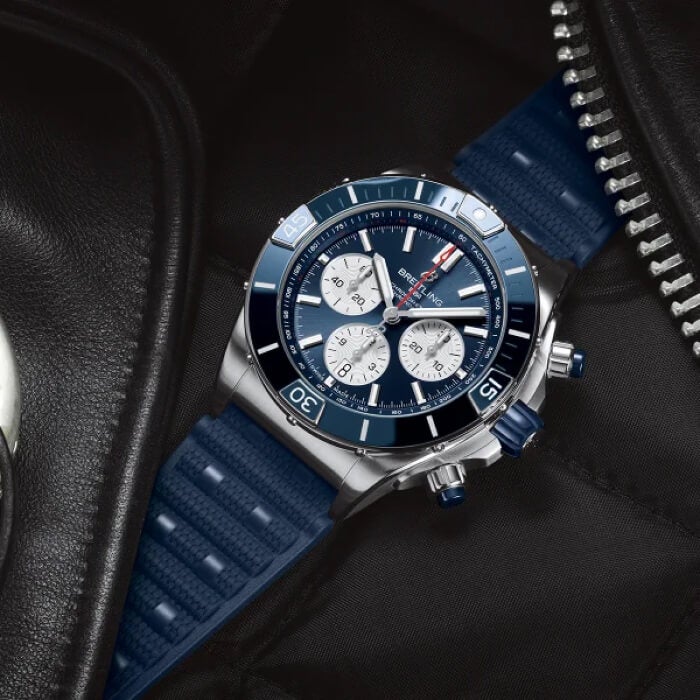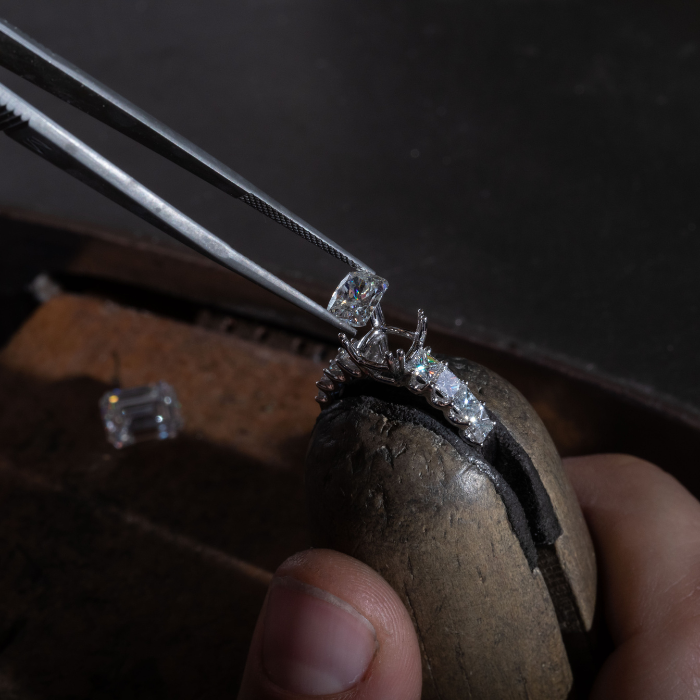THE BALLON BLEU DE CARTIER WATCH: A NEW VISION OF ROUNDNESS
The Ballon Bleu de Cartier watch epitomises Cartier's unique vision and its four creative focuses: the purity of the line, the precision of the proportions, the precious details and the accuracy of the shape.
The Ballon Bleu watch embodies the purity of lines by presenting a circle inside a circle. It has a monobloc construction, where the horns and crown cap blend into the middle case to form the appropriate case shape. Its apparent simplicity discloses a complex combination of intermingling circular and spherical forms and different volumes.
The precision of the proportions is the balance struck by Cartier to produce this creation’s overall sense of harmony. The watch has been crafted to meet the highest standards of comfort, whether held in the hand or worn on the wrist. The precious details are a result of the watchmaker's stylistic intuition, where aesthetics and technical expertise are explored together. The watch’s winding crown at three o’clock is one of its most recognisable features, with its blue cabochon integrated under a protective metal hoop. The accuracy of the shape is above all its exploration, an extensive search that culminates in a new vision of roundness. The case of Ballon Bleu is domed on both the front and back. As a watch designer, Cartier explores new territories and the effects of depth. Cartier pays homage to the great tradition of watchmaking and brings a new twist to its codes by transforming the “rail-track”, introducing the blue bubble, and adding the optical illusion of the domed sapphire crystal.
The history and the legend The Ballon Bleu de Cartier watch was created in 2007. Worn by both men and women alike, who appreciate its personality and comfort when worn, this piece has rapidly become a resounding success and a Cartier icon. Whether Fine Watchmaking models or jewellery versions, Ballon Bleu has inspired Cartier to create many different variants on metal bracelets or leather straps. The Ballon Blanc de Cartier watch is the ultra-feminine counterpart of Ballon Bleu, presenting smaller proportions and a precious design whose sophisticated elegance is enhanced by a diamond set at four o’clock. A unique spirit Every aspect of this watch is a matter of harmony, its interplay of volumes making it a precious object to be nestled in the palm of the hand. The piece’s feeling of softness marks out its harmony.
THE PANTHÈRE DE CARTIER WATCH - WATCHMAKING MEETS JEWELLERY
The instantly recognisable Panthère de Cartier watch is defined above all by its design. A square with rounded corners, the seamless curve of the horns, and visible rivets: with the Panthère watch, Cartier aspires to clean lines without losing sight of the softness of the lines responsible for the timepiece’s femininity.
The Panthère watch takes its name from the bracelet, which is one of its most characteristic design features. Its ultra-flexible structure echoes the movements of the Maison’s emblematic animal. Formed from a series of curved and polished links, it is uniquely supple.
The precise proportions of the bracelet and case can be seen in the way the Panthère watch is worn, its elegance determined by its ergonomics as it naturally fits around the wrist.
It is this original precision that allows Cartier to rework the proportions of the pieces according to the times without distorting them and to always go further, as it did in 2017 when relaunching the Panthère watch. While staying true to the original, the watch has benefited from several innovations, some remain undetectable, to bring it right up to date. These include the whiter dial, tighter links, the openwork and lacquer pixelated effect. Achieving a tauter bracelet and the removal of the date on the dial further accentuates its jewellery aspects.
When it was launched in 1983, the Panthère de Cartier watch reinvented the concept of a jewellery watch. This best-selling watch was embraced by the fun-loving 80s, proving particularly popular with the art scene.
Above and beyond its design, this watch slinks onto the skin in a rippling celebration of triumphant and carefree femininity. A state of mind embodied by the vibrant and sophisticated icons of the 80s and continued today by a whole new generation of bold and impeccably stylish women.
THE RECTANGULAR TANK WATCH: THE INTUITION OF A VISIONARY
In the design of the Tank watch, four main principles governing Cartier’s entire creative approach converge: the purity of the line, the accuracy of the shape, the precision of the proportions, and precious details. For Cartier, it all must start with the design.
The purity of the lines communicates Cartier’s desire to pare down lines and perspectives and to find the simplest expression of every object. The structure becomes visible and instantly understandable. At the Maison, legend has it that Louis Cartier himself drew a parallel between the architecture of the Tank watch and the design of a combat vehicle viewed from above: the brancards, or sidebars, were the tracks and the case the turret.
In terms of the accuracy of the shape, formal research made it possible to move from a square (the dial) to a rectangle (the bracelet).
The precision of the proportions lies in the balance between the lines and shapes, the volume and harmony that emanate from the design and lend the Tank its remarkable elegance.
The precious details can be seen in the level of refinement applied to the watch by Cartier, from the set crown to the contrasting polished and satin-finished brancards, the finely crafted dial and the blued-steel hands.
At the start of the 20th century, Louis Cartier undertook formal research with the aim of incorporating the hour circle into the lines of the bracelet and to refine and ultimately integrate the design of the horns so that they continue from the case onto the bracelet.
Although first developed by Cartier in late 1916, the Tank wasn't launched until 1919. Between 15 November and 26 December 1919, six pieces were added to stock; on 17 January of the following year, none were left.
The Tank is the watch of aesthetes and creatives looking for ultimate elegance, who appreciate it for its pure design.
Roman numerals mark the hours on the majority of the Tank watches. The dial features a "rail-track": a double line with a minute scale. Its design resembles the tracks of a railway line. A true Cartier signature, this graphic can be found on the dial of watches from the Tank collection. The "rail-track" and Roman numerals intensify the visual power of the dial. On the Tank watch, the strap attachments (horns) are incorporated into the case by the twin parallel lines of the brancards. Beaded or with rounded sides, the winding crown is set with a sapphire cabochon.
THE SANTOS DE CARTIER WATCH: 1904: THE FIRST WATCH DESIGNED TO BE WORN ON THE WRIST
The design of the Santos watch epitomises Cartier watchmaking, drawing on the concept of form, a taste for minimalism, the precision of the proportions and finally, an eye for detail.
The accuracy of the shape lies above all in its exploration. Cartier broke ground by imagining a square watch in a world dominated by round ones. But what to do with the square form of the Santos de Cartier watch? The Maison took a designer’s approach, recognising the symmetry presented by such a unique square. The jeweller used curves to round corners, as witnessed in the wide symmetrical bevels and the curving horns that converge towards the bracelet to add movement.
The piece's attention to detail can be seen in the stylistic intuition of a jeweller who sees beauty wherever it is and dares to show what others hide. Cartier made the radical decision to leave the functional rivets visible, used to attach the bezel of the Santos watch to its case. The details must have meaning and not be featured aimlessly or artificially. These are pieces of great value, and Cartier is ready to let this show, including on the now iconic metal bracelet designed in 1978, where the visible rivets echo the design of the case.
The precision of the proportions is the balance between the lines and shapes, the volume and harmony that emanate from the design. The precision of the Santos watch can be seen in the way it is worn and how it hugs the wrist. Since the beginning, attention has been paid to its ergonomics and practicality. It is this original precision that allows Cartier to rework the proportions of the Santos watch according to the times.
Redesigned in 2018 by the Cartier design studios, the timepiece evolves and innovates in accordance with the Santos codes. The design of the bezel has been updated to favour the synergy between the lines of the case and the strap. These sleeker lines accentuate the stylistic dynamic of the watch. The watch is designed for a perfect fit on the wrist and has been precisely weighted and measured to optimise comfort and ergonomics. In accordance with the philosophy of the 1904 watch and the pioneering spirit of Santos Dumont, the new Santos de Cartier watch incorporates numerous innovations. Two can be seen on the bracelet, amounting to 18 months of research: the patented QuickSwitch system, which allows the wearer to easily swap the metal bracelet and leather strap. The metal bracelet also benefits from the patented SmartLink technology, which allows the length of the bracelet to be adjusted without the use of tools. The new 2019 version of the folding buckle, meanwhile, offers an even more ergonomic, reliable and interchangeable system.
The 1847 MC movement, entirely developed and manufactured by Cartier, presents a high standard of performance and reliability. The Santos de Cartier watch is water-resistant to 10 bar (approx. 100 metres), can withstand magnetism up to 1,200 G, and has an accuracy of -3/+7 seconds per day.
Simplicity. Practicality. Innovation. These were the three major principles of Alberto Santos-Dumont, the aviation pioneer. Every single one of his projects was guided by the desire to make further progress. In 1904, Louis Cartier granted the famous aviator's wish: to be able to tell the time while flying, manning the controls of his plane without having to stop to check his pocket watch. He revolutionised watchmaking by creating the first modern wristwatch.
It is the watch of a man who set his sights high, designed over 22 flying machines, presented countless patent applications and risked his life during every test flight. A man who donated part of his profits to charity and who invented a practical yet elegant wardrobe.
A quest for pared-down simplicity and clear-cut lines characterise the Santos de Cartier watch. Cartier's style thus evolved with the times, inspired by the changes visible in Paris. The appearance of rectangular lines or radiating patterns under Haussmann's renovations likely influenced Cartier watches' aesthetics. The time is encased in simple, geometric, easy-to-read shapes.
With Santos de Cartier, the watch would become an accessory visible to all, now displayed on the wrist instead of being tucked inside a pocket and only ever removed to be used. When it was made available for sale in 1911, the watch proved a considerable success. In 1978, Santos de Cartier made a reappearance, this time on a bracelet in gold and steel – a bold pairing of materials previously unseen at Cartier. In the jeweller's hands, the steel was refined, polished and satin-finished, creating an incredibly bold, contrasted combination that was received with acclaim. The combination was incredible, the success even more so. With its visible rivets, three-dimensional bezel and streamlined bracelet, the Santos watch presents a bold style in tune with a flamboyant time.
Conquer the skies, lift spirits and fight the force of gravity: the daring legacy of aviator Alberto Santos-Dumont soars over the new Santos collections. They perpetuate the spirit, style and thirst for altitude held by men who change the world, just like Alberto Santos-Dumont.













